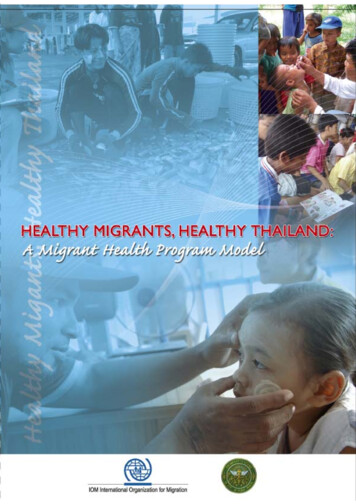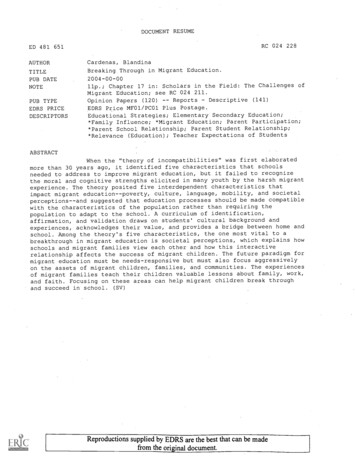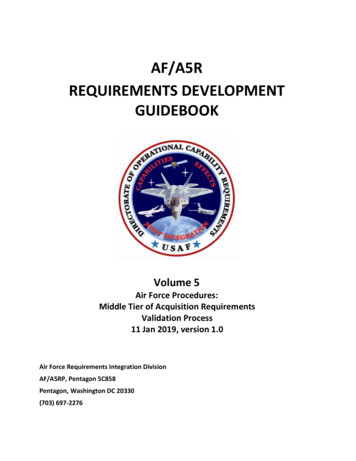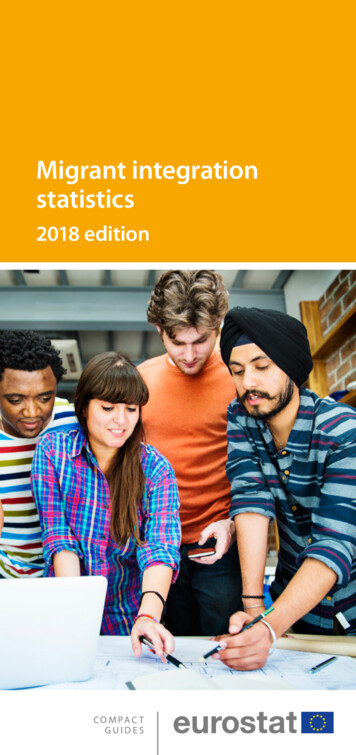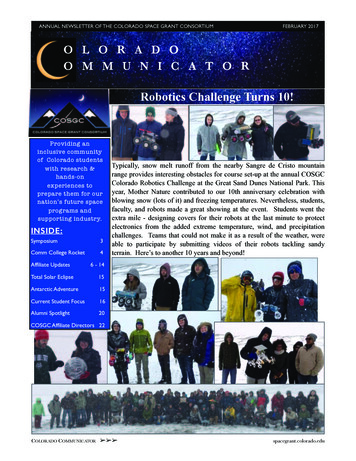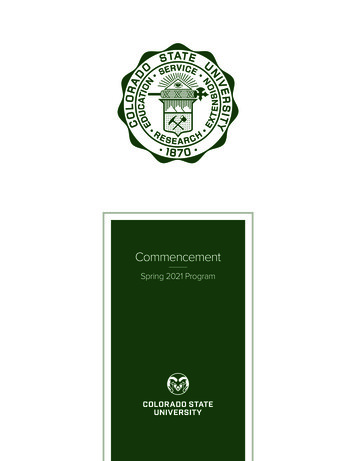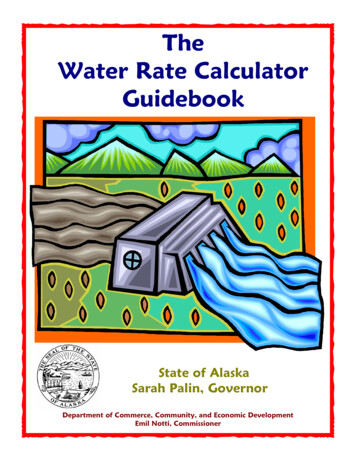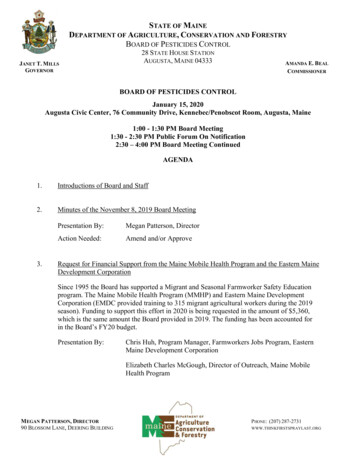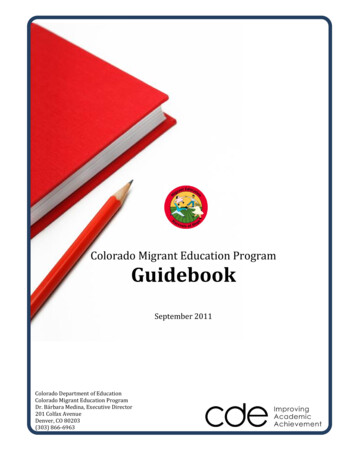
Transcription
Colorado Migrant Education ProgramGuidebookSeptember 2011Colorado Department of EducationColorado Migrant Education ProgramDr. Bárbara Medina, Executive Director201 Colfax AvenueDenver, CO 80203(303) 866-6963
Table of ContentsIntroduction . 3Part I - Introduction . 4Glossary of Acronyms . 4Director’s Letter of Introduction to the Guidebook . 5Purpose for the Guidebook . 5Introduction to the Colorado Model for Planning MEP Services . 5How the Guidebook is Organized . 7About the Migrant Education Program: Compliance and Accountability . 8Part II - About the Migrant Education Program: Compliance and Accountability . 9Purpose of the Migrant Education Program . 9Authorizing Statute and Non-Regulatory Guidance . 9Identification and Recruitment (ID&R).10Monitoring by the SEA .12MEP Data Checklist for the Monitoring Tool .13Gathering Evidence to Determine Progress Toward MPOs .14Reporting Requirements and Timelines .15Model for Planning MEP Services.18Conducting a Comprehensive Needs Assessment .19Purpose for Conducting a Needs Assessment.19How and When to Conduct a Local Needs Assessment .19Needs Assessment Data Collection Tools .21Planning for Service Delivery .28Service Delivery Plan (SDP) Process Overview .28How and When to Plan Services .29Strategic Planning Chart of Measurable Program Outcomes (MPOs) .30Applying for Funding as a Subgrantee of CDE .38How to Apply .38Implementing Services to Improve Migrant Student Achievement .40Overview of Programs and Resources .40Instructional and Support Services .40Pre-kindergarten (PK) .41Elementary .43Secondary .43Out-of-school Youth (OSY) .48Inter and Intrastate Coordination .60Professional Development and Technical Assistance .62Parent Involvement.63Collecting and Reporting Data to Improve Migrant Student Achievement.79Student Assessment.79Recording Data in the New Generation System (NGS) .80Migrant Student Information Exchange (MSIX) .84Evaluation Data Reporting Forms and Forms Checklist .85Using Evaluation Results for Program Improvement .100Evaluation Overview .100Action Plan for MEP Improvement .100
Part IIntroductionColorado MEP Guidebook September 2011
Part I - IntroductionGlossary of AcronymsATIMEPBMEIBOCESCAMPCDECELA ProCEUAuditing Tool for Improving MEP ServicesBinational Migrant Education InitiativeBoard of Cooperative Educational ServicesCollege Assistance Migrant ProgramColorado Department of EducationColorado English Language AssessmentProgramContinuing Education UnitCNACOECPKPCPPCSAPCSPRECEComprehensive Needs AssessmentCertificate of EligibilityColorado Pre-Kindergarten ProgramColorado Preschool ProjectColorado Student Assessment ProgramConsolidated State Performance ReportEarly Childhood EducationEducation Department General AdministrativeRegulationsEnglish Language Learner (also EL for EnglishLearner)End of EligibilityElementary and Secondary Education ActEnglish as a Second LanguageFiscal YearGovernmental Accounting Standards BoardGeneral Education Provisions ActHigh SchoolHigh School Equivalency ProgramIndividual Career and Academic PlanIdentification and RecruitmentInterstate Migrant Education D&RIMECIMSLEA andLOALCELearn-2SucceedMEESInformation Management System (at CDE)Local Education Agency/Local OperatingAgencyLanguage, Culture and Equity Unit of theColorado Department of EducationMEP consortium focused on readingMigrant Education Even StartColorado MEP ASESSMYLISOSYSWPSYTAMEP consortium focused on mathMigrant Education ProgramMigrant Parent Advisory CouncilMeasureable Program OutcomesMigrant Student Records ExchangeMigrant Youth Advisory CouncilNational Association of State Directors ofMigrant EducationNew Directors OrientationNew Generation SystemNon-Regulatory GuidanceOffice of Management and BudgetOffice of Migrant EducationOut-of-School YouthParent Advisory CouncilPortable Assisted Study SequenceProfessional DevelopmentPriority for ServicesParent Involvement MeetingPre-school/Pre-kindergartenRequired Data ElementsReading is FundamentalResponse to InterventionScientifically-based ResearchScientifically-based Reading ResearchService Delivery PlanState Education Agency (refers to CDE)Supplemental Education ServicesSummer Migrant Youth LeadershipInstituteMEP Consortium: Solutions for Out-ofSchool YouthSchool wide programSchool YearTechnical Assistance4
Director’s Letter of Introduction to the GuidebookWelcome to the Migrant Education Program Guidebook.The Colorado Department of Education applies for funding for all Federalgrants via a unified application. The Title I-C (Migrant Education Program)grant is a State Education Agency grant administered by the Office ofLanguage, Culture, and Equity (LCE). A regional and LEA subgranteeprocess is in place for school districts and BOCES (Boards of CooperativeEducational Services) to apply for a sub-grant from CDE.Our intention is to provide this Guidebook as a resource for school districtsand BOCES staff applying, implementing, and operating an MEP in the Stateof Colorado. In addition to the Guidebook, the LCE Unit will provide CDROMs with resources, conduct topic-specific webinars, and provide trainingand technical assistance.We strive to continually improve our documentation and communicationregarding the administration of Title I-C, MEP. Thus, we welcome yourfeedback on this second edition of the MEP Guidebook.Dr. Bárbara MedinaState MEP DirectorPurpose for the GuidebookThe Guidebook was compiled by the Colorado Department of Education Migrant EducationProgram to provide users with conveniently packaged tools and resources for understanding theMEP, planning services to migrant children and youth, conducting a local needs assessment, andreporting evaluation results. Internet links and program resources are included to facilitate furtherexploration of these topics.Services to migrant students in Colorado are governed by the State Migrant Education Program(MEP) Service Delivery Plan (SDP). The Guidebook is a tool for local MEP directors, coordinators,and staff responsible for designing and implementing programs and for collecting and reportingdata on the effectiveness of programs and services designed to meet the needs of migrant students.The Guidebook contains guidance on conducting program evaluations; using data tracking forms toreport outcomes to the State; identifying and using student assessment results as well as staff andparent surveys; and offering ideas on how to use data for improving MEP services.Introduction to the Colorado Model for Planning MEP ServicesThe graphic on the following page represents the continuous planning and improvement processused by the Colorado MEP. The State uses this model as a guide to ensure that services areColorado MEP Guidebook5
strategically planned, delivered, and evaluated. The Migrant Education Program ComprehensiveNeeds Assessment (CNA) identifies student needs after collecting and analyzing achievement data,other outcome data such as graduation information, and parent and staff perceptions. The CNAinforms the Service Delivery Plan (SDP) where strategies for meeting needs are identified andmeasurable program outcomes (MPOs) are set.Once needs have been assessed and services for meeting those needs planned, the region/districtuses this information to apply to the SEA for a local operating agency sub-allocation to supportthe implementation of program services. Program implementation involves not only the deliveryof instructional services but also includes support services, professional development, parentinvolvement, and inter/intrastate coordination efforts that feed into providing the best servicespossible to meet migrant children and youth’s identified needs. For accountability purposes, it isimportant to collect and report data about the services provided and evaluate how the impact ofthose services are perceived by parents and migrant staff.Finally, the program evaluation aspect of the model measures the effectiveness of the programthrough the data collected to help inform the improvement of the program. Evaluation data thenfeeds back into the CNA and the process begins the next cycle.Identification & Recruitment (ID&R)The ColoradoModel for PlanningComprehensiveMEP ServicesColorado MEP GuidebookAdditional Components: professionaldevelopment parent involvement alignment with CDEinitiatives technical assistance andmonitoring inter/intrastatecoordination migrant student ID&R curriculum, instruction,assessment health services6
How the Guidebook is OrganizedIn addition to this brief introduction (Part I), the Guidebook contains sections on Compliance andAccountability (Part II) and the Model for Planning, Implementing, and Evaluating MEP Services.Each of the six areas of the model described on the previous page (CNA, SDP, Application/Suballocation, Implementation, Data Collection/Reporting, and Program Evaluation) serves as a sectionin Part III.The Planning Cycle contains a reference to the major components of planning and implementing aMEP. The Guidebook is organized to allow the audience to include new materials as they becomeavailable and replace pages as materials are updated.The intended audience for the Guidebook is MEP program directors and coordinators in Colorado.Directors should familiarize themselves with the content and materials on an as-needed basis.The Colorado Department of Education will update the Guidebook annually at the beginning of theschool year to provide directors with the most recent materials and resources needed to implementMEPs in the State of Colorado. The State will distribute CD-ROMs containing resource materials formigrant education program implementation to accompany this Guidebook. Technical assistance tosupport the use of the Guidebook will be provided by CDE.For further information on the Colorado Migrant Education Program, contact:Dr. Bárbara Medina, Executive DirectorLanguage, Culture, and Equity UnitColorado Department of Education201 East Colfax AvenueDenver, CO 80203(303) 866-6963Medina B@cde.state.co.usColorado MEP Guidebook7
Part IIAbout the MigrantEducationProgram:Compliance andAccountabilityColorado MEP Guidebook September 2011
Part II - About the Migrant Education Program: Compliance andAccountabilityPurpose of the Migrant Education ProgramThe Migrant Education Program is a Federally-funded, supplemental educational program for thechildren of migratory agricultural workers and others who are determined eligible on Certificatesof Eligibility (COEs). According to the No Child Left Behind Act of 2001 (NCLB), the purpose ofMigrant Education is to: Support high-quality and comprehensive educational programs for migratory children tohelp reduce the educational disruption and other problems that result from repeatedmoves; Ensure that migratory children who move among the states are not penalized in anymanner by disparities among the states in curriculum, graduation requirements, and stateacademic content and student academic achievement standards; Ensure that migratory children are provided with appropriate educational services(including supportive services) that address their special needs in a coordinated andefficient manner; Ensure that migratory children receive full and appropriate opportunities to meet the samechallenging state academic content and achievement standards that all children areexpected to meet; Design programs to help migratory children overcome educational disruption, cultural andlanguage barriers, social isolation, various health-related problems, and other factors thatinhibit the ability of such children to make a successful transition to postsecondaryeducation or employment; and Ensure that migratory children benefit from state and local systemic reforms.Through local education agencies and local operating agencies, the MEP helps children and youthby providing supplementary services beyond those provided in schools (e.g., develop oral andwritten language, and communication skills; reading and mathematics; and provides support formigrant students to accrue high school credit or attain a GED).Authorizing Statute and Non-Regulatory GuidanceThe Migrant Education Program is authorized by Part C of Title I of the Elementary and SecondaryEducation Act (ESEA) reauthorized as the No Child Left Behind Act of 2001 (NCLB). The MEPprovides formula grants to State educational agencies (SEAs) to establish or improve educationprograms for migrant children. These subgrants assist States in improving educationalopportunities for migrant children to help them succeed in the regular school program, meet thechallenging State academic content and student academic achievement standards that all childrenare expected to meet, and graduate from high school.The Office of Migrant Education published non-regulatory guidance (NRG) to aid states andprograms in interpreting how the MEP should be operated. The draft guidance is found online:cde.state.co.us/cde english/download/Migrant/MIGRANTGUIDANCE2010.pdf. It follows aColorado MEP Guidebook9
question-and-answer format written in plain language so that it is easy to follow and can be usedfor training and learning about the program. It is recommended that all program directors becomefamiliar with the NRG.Upon reauthorization of the statute, it is expected that new guidance also will be published.Directors should watch for changes to the statute and the publication of new guidance. Training insubsequent years will include revisions to the Guidebook pursuant to changes in legislation andguidance.Identification and Recruitment (ID&R)The Office of Migrant Education (OME) has identified the need for special initiatives in threeprogrammatic areas of the MEP to help attain the goal of assisting migrant children to achievechallenging academic standards and graduate from high school. One of these areas is the programfunction of targeting, which includes the following:1. proper and timely identification and recruitment of eligible students—especially those whoare the most mobile;2. selection of students for services based on priority for service and need; and3. provision of services at a sufficient level of quality and intensity to give a reasonablepromise of meeting the needs of the children being served.Identifying and recruiting eligible migrant children is a cornerstone of the MEP. Identificationmeans determining the presence and location of migratory children within a State. Recruitmentmeans describing the benefits of the MEP to the child and his or her family and obtaining thenecessary information to document the child's eligibility and enroll the child in the program.Identification and recruitment of migrant children are critical because: The children who are most in need of program services are often those who are the mostdifficult to find. Many migrant children would not fully benefit from school, and in some cases, would notattend school at all, if the State educational agencies (SEAs) failed to identify and recruitthem into the MEP. Children cannot receive MEP services without documentation of eligibility.As each SEA is responsible for the identification and recruitment of all eligible migrant children inthe State, Colorado must develop and implement policies and procedures that efficiently andeffectively meet their responsibility to correctly identify and recruit all eligible migrant childrenresiding in the State. State MEP funding is based, in part, on the annual count of eligible migratorychildren.Colorado MEP Guidebook10
ID&R Coordinators, migrant recruiters, and other ID&R experts have identified the following needsas being important to ensuring the proper and timely identification and recruitment of eligiblemigrant children:1.2.3.4.5.6.7.8.9.a communication and dissemination networkinformation on best practicesa standard ID&R manualclarification on various types of qualifying movesupdated guidancemore timely responses from OME to ID&R questionsregular and consistent training for recruitersthe expanded use of technology to support ID&R effortsdocumentation of outreach to districts assigned to regional programs or school in a districtDescriptionIn 2000, the Office of Migrant Education launched an ID&R initiative that brings together StateID&R Coordinators, OME staff, and others with expertise in the identification and recruitment ofmigrant students to improve current knowledge on (1) administrative procedures for effectiveID&R systems, and (2) high-quality training materials for recruitment personnel. The primaryobjective of this initiative is to help State Migrant Education Programs conduct timely and properidentification and recruitment of eligible migrant children.The components of the ID&R Initiative support the continued improvement of migrant childidentification and recruitment. Specifically, OME’s ID&R Initiative works to:1. establish and sustain a professional network of ID&R coordinators,2. develop resources that help States strengthen their identification and recruitment practicesand quality control systems to ensure effective targeting,3. disseminate "best practices" for migrant child identification and recruitment anddetermining migrant child eligibility, and4. update and improve access to current Federal policy guidance on migrant child eligibility,identification, and recruitment.MEP ID & R Training CurriculumThe Colorado SEA/MEP adopted The National Identification and Recruitment Curriculum as amandatory requirement for implementation by recruiters and all MEP staff. The curriculum wasprepared by the Migrant Education Resource Center, funded by the U.S Department of Education,Office of Migrant Education. A copy of materials included in the National ID&R Curriculum isavailable at http://results.ed.gov/node/143.The curriculum design provides a framework for recruiter development and progression along acontinuum. Modules have been divided into three levels – basic, intermediate, and advanced. Basicmodules are designed primarily to introduce the MEP to new recruiters. Intermediate modules areColorado MEP Guidebook11
most suited for recruiters with one to five years of experience wishing to learn more advancedconcepts and skills. Advanced modules are designed to introduce veteran recruiters with more thanfive years of recruiting experience to more advanced concepts and help prepare them to take on alarger leadership role in the MEP. However, veteran recruiters will also find basic and intermediatemodules useful as refresher training.The SEA will provide training throughout the year with opportunities to participate in the differentlevels of the modules. The following forms, resources, and tools are available atwww.cde.state.co.us/cde english/elau migrant.htm.1.2.3.4.5.6.7.8.9.ID&R Guidebook 2011 (Fall estimated arrival)MEP Definitions PosterBasic Migrant Child Eligibility Factors HandoutCertificate of Eligibility (COE)Recruiter and Data Specialist WorksheetColorado Agricultural MapNotification of Rights Under FERPAMEP MapResidency VerificationMonitoring by the SEAThe SEA uses the Auditing Tool for Improving MEP Services (ATIMEP) when visiting programs tomonitor progress toward meeting measurable program outcomes. The tool is a comprehensiverubric covering all aspects of program management and service delivery. Through the use of thistool, the auditor visiting the program will determine the effectiveness of the Migrant EducationProgram in areas aligned with the strategic planning cycle discussed in the previous section: projectmanagement, identification, recruitment, project implementation, and evaluation.Monitoring visits are conducted annually or as needed and may be completed by the State directoror designee. Programs can expect to receive a visit every other year with desk monitoring beingcompleted during the years off program visit schedule. Prior to the monitoring visits or deskmonitoring, programs review the ATIMEP and prepare necessary documentation. The major areasof the MEP that will be reviewed by CDE include:I. Project ManagementII. Identification and RecruitmentIII. Project Implementation—Alignment to Service Delivery Plan andComprehensive Needs AssessmentDirectors can access a copy of the ATIMEP at state.co.us/cde english/elau migrant.htm, or bycontacting CDE at (303) 866-6963.Colorado MEP Guidebook12
With respect to monitoring, migrant education programs should be ready to present evidence ofprogress made toward meeting the Measureable Program Outcomes. A short checklist to use whenpreparing for monitoring is included below.MEP Data Checklist for the Monitoring ToolInstructions: In preparation for a State onsite or desk monitoring, ensure that the data anddocumentation listed below are available. Your program may have additional documentation tosupport progress toward achievement of the Measureable Program Outcomes that should beprepared as well.Evidence for ATIMEP RubricProject Management Staff list with roles andresponsibilities Education of Migratory ChildrenApplication for the current schoolyear PFS list and methods for targetingservices Communications with school districts Equipment inventory List of collaborators Statewide assessment resultsIdentification and Recruitment Region wide recruitment plan Recruitment time & efforts logs ID&R procedures Recruiter and clerk training records Information on program services thatis distributed to familiesColorado MEP GuidebookProject Implementation Local needs assessment records PAC records and members list Parent involvement records Staff development records Documentation of home visits, schoolvisits, and referrals Pupil-tutor ratio Coordination plan for tutors andteachers Secondary credit accrual plan Migrant health needs State initiativeso SMYLIo SOSYo LEARN-2-Succeedo Math MASTERSo Binational13
Gathering Evidence to Determine Progress Toward MPOsImplementation and Outcome Evaluation FormsData CollectionForm/Instrument Parent Survey Preschool Student TrackingForm Preschool OutcomesChecklist CSAP Reading, Math, andWriting Results CBLA Results MASTERS Student Roster andAssessment form Migrant Student DropoutRate for Grades 7-12 Secondary/OSY TrackingForm Recruiter Survey Staff SurveyPerson CompletingMigrant ParentsSite DirectorsTeachersSEASEAMASTERS SiteDirectorsSEASite DirectorsRecruitersMEP Teachers/ParaprofessionalsPurposeMPOs 1a, 2d, 3c & 4dMPO 1bPreschool student school readinessassessment (used to complete thetracking form)MPOs 2a, 2c, 3aMPO 2bMPO 3bMPO 4aMPOs 4b & 4cImplementation evaluationImplementation evaluationPlease ensure that all of the information listed above is collected and submitted toMETA Associates no later than June 30 annually. Please call us at any time with questionsor concerns.META Associates518 Old Santa Fe Trail, Suite #1-208Santa Fe, NM 87505(303) 550-3333 – Phone(888) 234-9665 – Faxduron1@aol.commarty@meta1.usColorado MEP Guidebook14
Reporting Requirements and TimelinesThe following is a list of reports and data that the State requires of each MEP. As appropriate,templates for these reports are included on the CDE website. The SEA reserves the right to add to ordelete reports as may be required by CDE or OME.Required ActivityActive/Inactive FilingDeadlineOngoingAge Appropriate toGradeAgricultural SurveyOngoingAttending WithdrawalsWithin 5business daysafter notificationfor earlywithdrawal orend of schoolyearUpon request ofinitial access toNGSOctober 31,current yearColorado SecurityAgreementConsolidated StatePerformance Report(CSPR)New SchoolEnrollmentContinuation of ServicesUpon receipt,end of eligibilityDrop Out IndicatorWithin 5business days ofnotificationWithin 5business days ofenrollmentOngoingEnrollment TypeExisting COEsColorado MEP GuidebookRequirementEach program is required to keep on file,COEs for seven years from the date ofeligibility on both active and inactiveCOE’sGrade level must be appropriate to ageCommentsAll COE information must bekept secure and locked to protectstudent’s identityWithdraw all students prior to adding anew enrollment line. Regular yearwithdrawals must be completed by 6/10,current yearAll withdrawals must becompleted by the end of term(regular, summer)New School Enrollment PacketEach user is required to sign the ColoradoSecurity Agreement Form prior to beinggiven access to NGSThe CSPR is a federal reporting tool on allmigrant children recruited, counted andserved, current yearThe “continuation of services”: (1) a childwho ceases to be a migratory child duringa school term shall be eligible for servicesuntil the end of such term; (2) a child whois no longer a migratory child maycontinue to receive services for oneadditional school year, but only ifcomparable services are not availablethrough other programs; and (3)secondary school students who wereeligible for services in secondary schoolmay continue to be served through creditaccrual programs until graduation.Students who have been identified by thedistrict as being dropped outR Regular Year enrollmentS Summer Year enrollmentP Residency Only enrollmentFamilies in their 2nd and 3rd year ofeligibility. Enrollments entered by 8/31,current yearUnless authorized by the schooldistrictMonthly contact with schools fornew agricultural surveyRequired for all NGS usersAll MEP programs are to reportrequired student information onall children recruited, countedand served; current year fortheir programContinuation of Service studentsshould not be counted as eligiblein Category 1 or Category 2;these students participate in theMEP but do not generate MEPfunds.A drop out indicator must bechecked in the studentsenrollment lineActive COEs,15
Required ActivityFacility UpdatesContact InformationHigh School CreditAccrual/SecondaryCreditImmunization RecordInformal AssessmentProficiencyLanguage ProficiencyDesignationMedical Alert IndicatorMove NotificationNew COE’sNew Facility RequestNGS Termination UserRequestNGS TrainingDeadlineWithin 5business days ofnotificationWithin 5business days ofnotificationWithin 5business days ofinitial enrollmentWithin 5business days ofnotificationWithin 30 daysof initialenrollmentWithin 5business days ofnotificationWithin 5business days ofnotificationOngoingWithin 5business days ofnotification or byDecember 31,current yearOngoing; uponrequestInitial, AnnuallyNGS User RequestOngoing; uponrequestPriority for ServicesWithin 30 daysof initialenrollmentQuality ControlOngoingColorado MEP GuidebookRequirementEach program is required to update theirfacility contact information upon receiptor annually, current yearStudents in grades 9-12 must have highschool credit accrual and/or secondarycredit en
The graphic on the following pa ge represents the continuous planning and improvement process used by the Colorado MEP. The State uses this model as a guide to ensure that services are . Welcome to the Migrant Education Program Guidebook. The Colorado Department of Education applies for funding for all Federal grants via a unified application.
